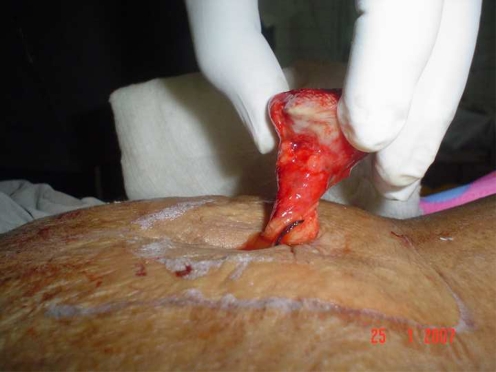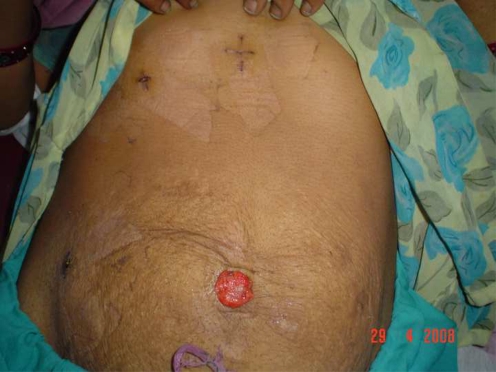Introduction
Trocar site hernias (TSH) is a rare but potentially dangerous complication of laparoscopic surgery. It’s incidence is approximately 0.477% [1]. Among TSH, omental herniation is very rare [2]. We report two cases of omental herniation through the laparoscopic port sites.
Case History
Case 1
A 44 year old, multipara female, underwent interval laparoscopic cholecystectomy for calculous cholecystitis. Pneumoperitoneum was created by Veeres needle and the cholecystectomy completed in 45 minutes. At the end of the surgery, pneumoperitoneum was decompressed spontaneously (without the use of suction) and ports, removed under vision. Fascial closure of the umbilical and epigastric ports was done with polyglactin Number 1. The post operative period was uneventful and the patient was discharged on the first postoperative day.
At home, the patient noticed a watery discharge from the umbilical wound followed by spontaneous prolapse of omentum on the 6th post operative day (Fig. 1). At presentation she was afebrile and her blood counts were normal. A viable portion of omentum was seen prolapsing through the umbilical port site. She underwent a laparotomy through a small midline incision and the prolapsed omentum was excised. Closure of the linea alba was done using Polypropylene sutures. She recovered uneventfully and was discharged on the 5th post-operative day.
Fig. 1.
Prolapse of omentum
Case 2
A 38 year old multipara lady presented to the emergency department (Fig. 2) with acute evisceration of omentum though the wound of the umbilical port. She had undergone laparoscopic cholecystectomy for multiple gallbladder calculi in a peripheral hospital 12 days back.
Fig. 2.
Port site - evisceration of omentum at the port site
The patient was afebrile with normal blood counts. The prolapsed omentum was viable. She underwent a laparotomy through a small midline incision. It did not reveal any pre-existing fascial defect (The trocar site fascial defect was repaired by polyglactin sutures). The prolapsed omentum was excised and the fascial defect closed with Polypropylene sutures. The patient had an uneventful recovery and was discharged on the 6th post- operative day.
Discussion
TSH, also referred to as ‘port site hernia’has been defined by Crist and Gadacz as the development of hernia at the canula insertion site [3].
Tonouchi, Ohmori, Kobayashi and Kusunoki have classified TSH into three types: a) early onset, b) late onset and c) special variety. Early and late onset types represent failure of fascial suturing. In both these varieties the skin sutures remain intact. While early onset type presents in the perioperative period, late onset type presents several months later. Special type indicates dehiscence of the entire abdominal wall withprotrusion of the intestine or greater omentum through the skin [4].
In our series both the patients belonged to the special type. Risk factors leading to TSH include: chronic bronchitis, increase in weight, malnutrition, calculi larger than 15 mm [5], wound extension, male sex, wound infection, diabetes, pre-existing umbilical hernia, acute cholecystitis [6], decompression of the pneumoperitoneum by suction1 [7], trocar diameter and trocar design [8]. Risk factors were absent in our patients. Both our patients were multipara females, suggesting that increased parity may put patients at risk via way of weakened abdominal muscles. Multiparity, as a risk factor for TSH has not been documented in previous studies.
Suggestions for prevention of TSH include: avoiding unnecessary wound extension, use of non- absorbable sutures for defects larger than 2 cm and in men with umbilical hernia [6].
Regarding the closure of the fascial defects, some authors advocate the closure of all midline fascial defects [7] whereas others advocate the closure of only large fascial defects (> or = 10 mm) [9]. Treatment of TSH involves reduction of herniating abdominal content and anatomical closure of the fascial defect using non-absorbable sutures.
Conclusion
TSH through port site is an uncommon but serious complication of laparoscopic surgery. With the domain of laparoscopic surgery ever increasing, the incidence of this complication is only expected to rise. Amongst a myriad of recommendations, meticulous closure of the fascial defects is possibly the only mean of preventing it.
References
- 1.Filip V, Plesa C, Tarcoveanu E, Bradea C, Moldovanu R. Incisional hernias after operative laparoscopy. Rev Med Chir Soc Med Nat lasi. 2000;104(4):83–86. [PubMed] [Google Scholar]
- 2.Haeusler G, Tempfer C, Gitsch G, Hanzal E. Omental evisceration after laparoscopic treatment of a tubal pregnancy. A case report and review of the literature. Gynecol Obstet Investig. 1998;45:66–67. doi: 10.1159/000009927. [DOI] [PubMed] [Google Scholar]
- 3.Crist DW, Gadacz TR. Complications of laparoscopic surgery. Surg Clin North Am. 1993;73:265–289. doi: 10.1016/s0039-6109(16)45981-5. [DOI] [PubMed] [Google Scholar]
- 4.Tonouchi H, Ohmori Y, Kobayashi M, Kusunoki M. Trocar site hernia. Arch Surg. 2004;139:1248–1256. doi: 10.1001/archsurg.139.11.1248. [DOI] [PubMed] [Google Scholar]
- 5.Coda A, Bossotti M, Ferri F, Mattio R, Ramellini G, Poma A, Quaglino F, Filippa C, Bona A. Incisonal hernia and fascial defect following laparoscopic surgery. Surg Laparosc Endosc Percutan Tech. 2000;10(1):34–38. [PubMed] [Google Scholar]
- 6.Nassar AH, Ashkar KA, Rashed AA, Abdulmoneum MG. Laparoscopic cholecystectomy and the umbilicus. Br J Surg. 1997;84(5):630–633. doi: 10.1002/bjs.1800840513. [DOI] [PubMed] [Google Scholar]
- 7.Bloom DA, Ehrlich RM. Omental evisceration through small laparoscopic port sites. J Endourol. 1993;7(1):31–32. doi: 10.1089/end.1993.7.31. [DOI] [PubMed] [Google Scholar]
- 8.Holzinger F, Klaiber C. Trocar site hernias. A rare but dangerous complication of laparospic surgery. Chirurg. 2002;73(9):899–904. doi: 10.1007/s00104-002-0525-2. [DOI] [PubMed] [Google Scholar]
- 9.Azurin DJ, Go LS, Arroyo LR, Kirkland ML. Trocar site herniation following laparoscopic cholecystectomy and the significance of an incidental preexisting umbilical hernia. Am Surg. 1995;61(8):718–720. [PubMed] [Google Scholar]




